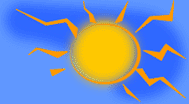|
 |
||||||||||||
|
Ocean waves are great carriers of energy and are generated by winds in mid-ocean.
As the wind blows constantly over a section of ocean, waves will form and their height and wavelength are a function of the
wind speed and "fetch" (the length of the section of ocean considered). There are basically two types of waves, transverse and longitudinal. Transverse water waves have motion which is perpendicular to the direction of energy.
The water particles of transverse waves don't actually move any horizontal distance away from their respective spots, and
only move vertically, in an up and down or circular motion. Ocean waves are considered to be transverse. Longitudinal waves move parallel to the direction of energy. The water particles of longitudinal
waves alternate between stretched and compressed conditions- similar to a slinky. Both
of these types of waves combine to create periodic waves with high and low points or “swells”. Swells are created primarily by wind, so the energy of the waves or swells comes from the wind. The same physics terms for light waves or sound waves also apply to water waves (period, frequency, wavelength,
amplitude, speed). With advance knowledge of the value of these terms based on
weather predictions, surfers can predict when a good swell will reach a certain prime surf spot, where it will “break”
best and how high it will be. For
good surfing, waves need to break in a certain manner. How a wave breaks depends
on depth and the floor of the ocean. Most often the ideal floor conditions are
reefs that catch waves at an angle allowing a wave to crest from one side to another creating an angled face. |
|||||||||||||
|
|
|||||||||||||
 |
|||||||||||||
|
|
|||||||||||||


